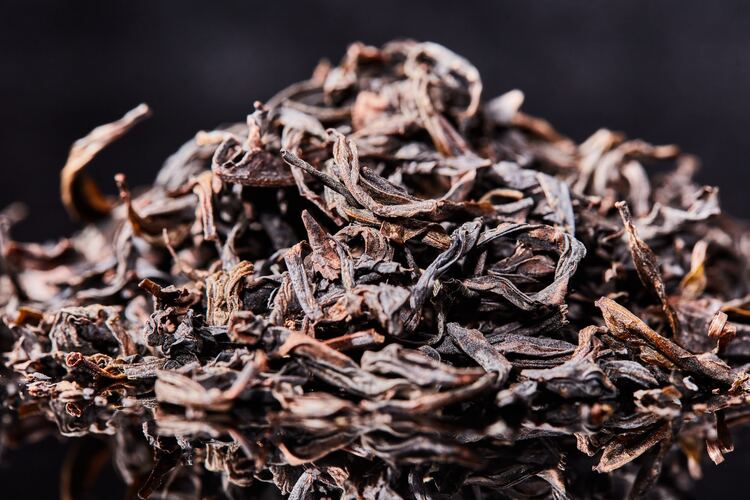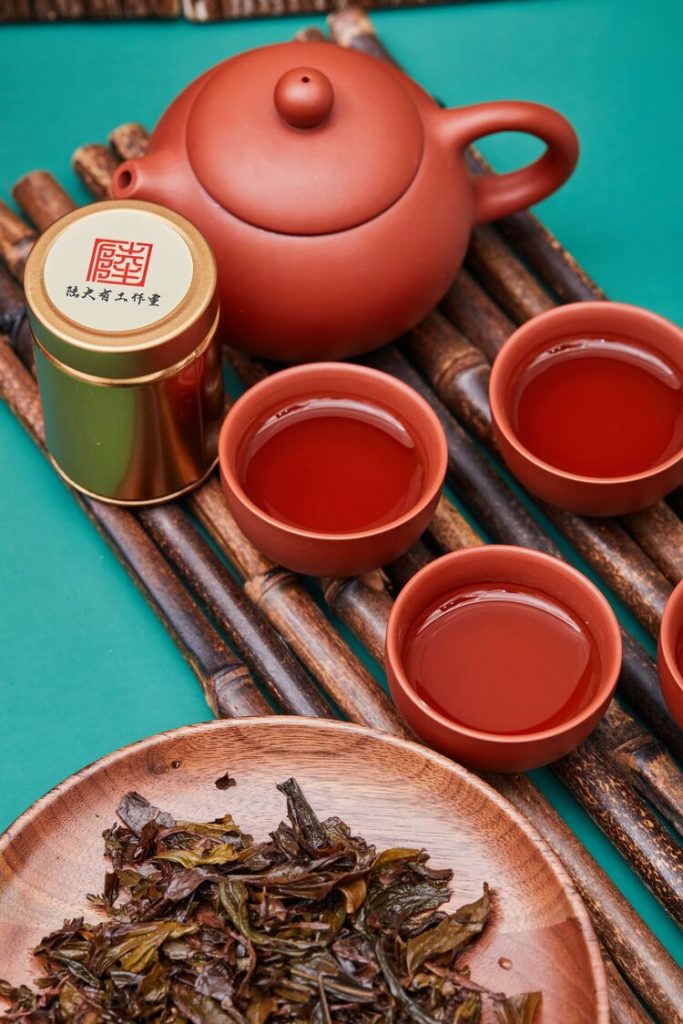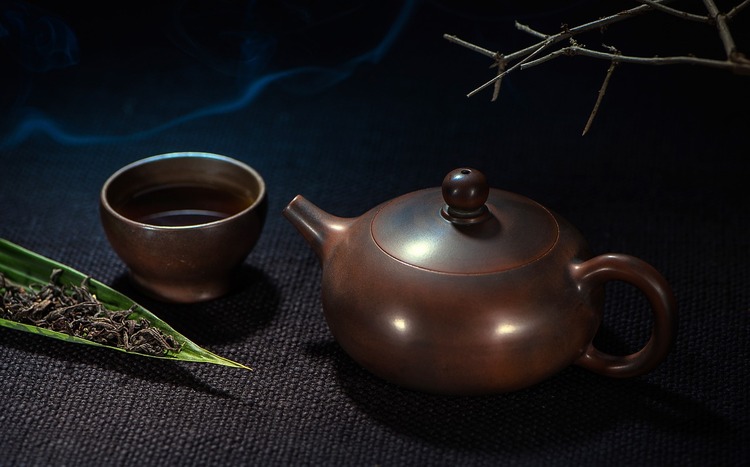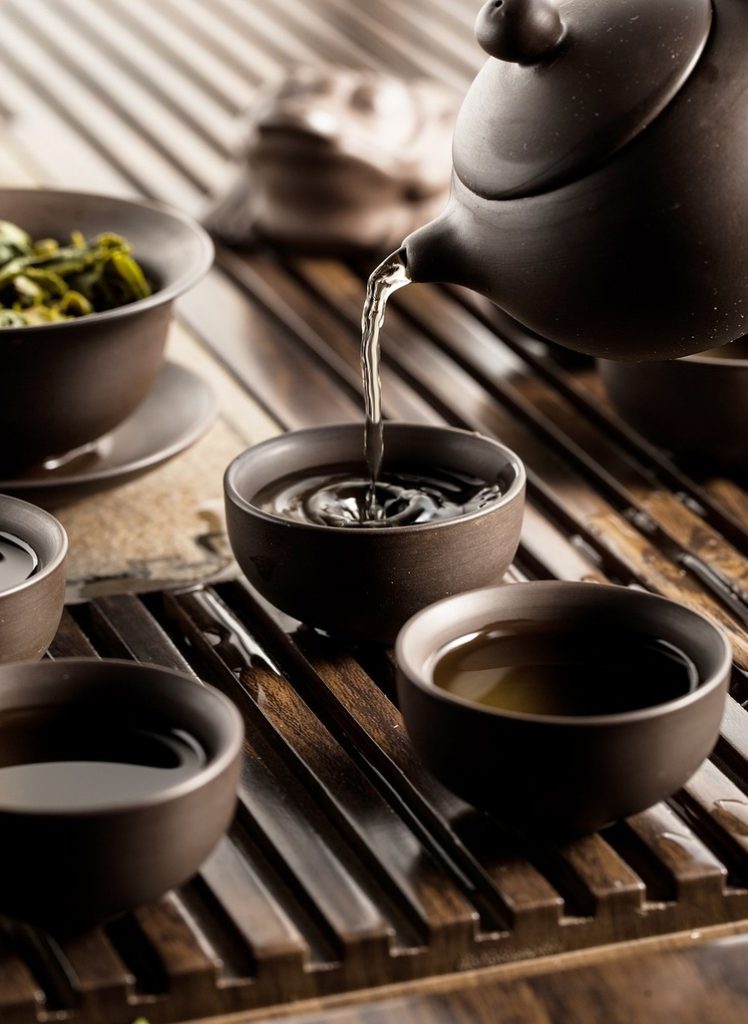Da Hong Pao is one of the most famous teas in China. It is a type of oolong tea that comes from the Wuyi Mountains in Fujian province. The name Da Hong Pao translates to “Big Red Robe,” and it’s said to have originated from a legend about a scholar who cured an emperor’s mother of an illness by drinking this tea.
Da Hong Pao is a highly prized tea. It’s known for its complex flavor profile, which includes notes of honey, fruit, and flowers. The tea is also famous for its long-lasting aftertaste, which can linger in your mouth for hours. Because of its characteristics and high quality, it is also one of the most expensive teas in the world.
Join us as we dig deeper into this tea’s history, processing, characteristics, and health benefits.
Please note: This article contains affiliate links, meaning I may earn a commission if you make a purchase by clicking a link. Of course, this comes at no extra cost to you and helps me keep offering readers solid information.

History of Da Hong Pao Tea
Origin and Legend
Da Hong Pao Tea is an oolong tea from the Wuyi Mountains in China’s Fujian province. The tea’s name comes from a legend about a scholar who cured an emperor’s mother of an illness by presenting her with tea made from the leaves of a particular tea tree. The emperor was so grateful that he draped the tree with red robes, which is why it is also known as Big Red Robe Tea.
Note: There are other legends explaining the tea’s origin.
Ming and Song Dynasty Influence
This tea has a long and rich history dating back to the Ming and Song dynasties. During the Ming dynasty, Da Hong Pao was considered a tribute tea and was only consumed by the royal family and high-ranking officials. In the Song dynasty, this tea was used for medicinal purposes and was believed to have healing properties.
Tea Trees
Da Hong Pao is produced from specific tea bushes that are believed to be several centuries old. These bushes are extremely rare and exist in limited quantities. There seems to be no agreement on the number of these ancient trees. Sources state 3 to 6 live.
In addition, these tea bushes grow on rocky cliffs, making cultivation labor-intensive and challenging. The rugged terrain and the need for manual labor, craftsmanship, and complex production methods increase the cost of cultivation and production.
The leaves from these ancient plants are carefully harvested and processed, resulting in a limited supply. Because of this, many tea connoisseurs affirm the annual harvest ends in the hands of the rich and powerful.
Because of this, there is a high probability that Da Hong Pao in the market comes from bushes propagated from the ancient trees or bushes bred from the ancient trees’ direct descendants. Buyers should acquire the product from a reputable vendor that can explain the tea’s origin.
Cultivation and Production
Wuyi Mountain Region
Da Hong Pao Tea is grown in the Wuyi Mountain region of China, located in the northern part of Fujian province. The region is known for its high-quality tea production (including oolongs), and the climate and soil contribute to this tea’s distinctive flavor.
Oolongs grown in the Wuyi Mountains are known as Wuyi oolongs, Yancha, or Rock Oolongs. Wuyi oolongs are prized for their complex, layered flavors. They often exhibit notes of mineral, rocky, roasted, floral, and fruity elements.
Processing
The leaves are carefully hand-picked, with only a few plucked from each bush (top two leaves and a bud) at a specific time (spring).
After picking the leaves, they are withered in the sun. This process allows the leaves to lose some of their moisture, making them pliable for subsequent processing steps. The duration of withering varies depending on environmental conditions.
The dried leaves are tossed and oxidized. Oolong teas undergo partial oxidation. Skilled tea artisans carefully control the oxidation level and determine when to halt the process. This oxidation step is essential for developing the tea’s complex flavors and aromas.
Following oxidation, the tea leaves are fired to halt the oxidation process and preserve the desired flavors and aromas.
The tea leaves are rolled and shaped to develop their unique appearance and flavor.
Roasting and Baking Process
The final step in the production is the roasting and baking process. The tea leaves are roasted in a special oven over charcoal, which gives them a smoky flavor. The leaves are then baked in a low-temperature oven to enhance their flavor and aroma further.
The roasting and baking process is crucial in producing Da Hong Pao tea, giving it its distinctive flavor and aroma. The process is carefully controlled to ensure that the tea is not over-roasted or over-baked, which can result in a bitter or burnt taste.
The cultivation and production of Da Hong Pao is a complex and time-consuming process that requires skill and expertise. Combining all these factors makes this tea one of the most expensive in the world.

Characteristics of Da Hong Pao
Flavor Profile
Here’s a description of the flavor profile of Da Hong Pao:
- Rich and Full-Bodied: Da Hong Pao has a full-bodied and robust flavor that lingers on the palate. It is often described as having a deep, velvety texture that coats the mouth.
- Orchid Fragrance: One of the defining characteristics of this tea is its delightful orchid-like aroma. The tea emits a floral scent that is both sweet and captivating. This orchid fragrance is considered a hallmark of high-quality Da Hong Pao.
- Fruitiness: Besides its floral notes, Da Hong Pao may exhibit hints of ripe fruits such as plum, peach, or apricot. These fruity undertones contribute to the tea’s complexity and add a layer of sweetness.
- Mineral and Earthy Notes: The mineral-rich soil of the Wuyi Mountains imparts a subtle mineral and earthy quality to the tea. This earthiness is often likened to a mild rock or mineral taste.
- Roasty and Nutty Undertones: The tea undergoes a roasting process, which imparts a pleasant roasted or toasty character. This roasting adds depth to the flavor profile and may include subtle nutty notes, such as almond or walnut.
- Sweet Finish: The tea finishes with a sweet aftertaste that lingers in the mouth. This sweetness is often described as honey-like or caramelized, rounding out the overall flavor experience.
- Balanced Astringency: While Da Hong Pao is known for its robustness, it is also carefully crafted to maintain a balanced level of astringency. This means the tea has a slight drying sensation on the palate but is not overly bitter or harsh.
- Complex and Evolving: Da Hong Pao’s flavor profile can evolve with each steeping, making it an exciting tea to savor over multiple infusions. As the leaves unfurl, different nuances and subtleties in taste and aroma may become more pronounced.
Appearance
The tea has a dark, rich color similar to mahogany wood. The leaves are twisted and curled, with a slightly glossy appearance. You will also notice a subtle sheen on the surface of the tea leaves, which is a result of the roasting process.
When brewed, Da Hong Pao has a deep red color that is clear and bright. The tea has a full-bodied texture and a smooth, velvety mouthfeel. The tea leaves unfurl during brewing, releasing a conglomerate of flavors.
Da Hong Pao Varieties
Now, let’s take a look at the different varieties of Da Hong Pao:
- Original or Traditional: This is the actual variety of Da Hong Pao, and it’s the one that most people think of when they hear the name. It is made from the leaves of the original tea bushes, believed to be centuries old. It has a rich, full-bodied flavor with notes of roasted nuts and dark chocolate. As mentioned in previous sections, these tea leaves may not be available in the market.
- Qidan: This variety is made from tea plants that are descended from the original plants (due to the limited supply of leaves from the actual tea bushes). It has a slightly sweeter flavor than the original, with notes of honey and caramel.
- Bei Dou: This variety is made from tea plants descended from the Qidan plants. It has a lighter, more delicate flavor than the other varieties, with notes of orchid and honey.
- Aged: Some Da Hong Pao varieties undergo a process of aging, which can range from a few years to several decades. Aging enhances the flavor profile, producing a smoother and more complex taste. Aged Da Hong Pao develops unique notes of earthiness, woodiness, and mellowness over time.
- Blended: Blending different batches or varieties of Da Hong Pao is a common practice to achieve specific flavor profiles or create unique combinations. Blended Da Hong Pao teas can offer a harmonious balance of flavors, combining the characteristics of different varieties.
Brewing Da Hong Pao
Gong Fu Brewing Method
If you want to enjoy the full flavor of Da Hong Pao, then the Gong Fu brewing method is recommended. This method involves using a small teapot (Yixing clay teapot) and brewing the tea in multiple short infusions. This brewing method ensures the best taste. Here’s how you can do it:
- Preheat your teapot and cups by rinsing them with hot water.
- Add the tea leaves to the teapot. The amount of tea leaves will depend on the size of your teapot, but a general guideline is 1-2 teaspoons of leaves for every 6-8 ounces of water.
- Pour hot water over the tea leaves and immediately pour it out. This helps to rinse the tea leaves and awaken their flavor.
- Refill the teapot with hot water and steep it for about 20-30 seconds.
- Pour the tea into your cups and enjoy the fragrant aroma and delicate taste.
- Repeat steps 4 and 5 for multiple infusions, gradually increasing the steeping time with each infusion. You can increase each infusion’s steeping time by 10 to 20 seconds.
Infusions
Da Hong Pao can be steeped multiple times, with each infusion bringing out different flavors and aromas. The first infusion will have a strong, roasted flavor with a hint of sweetness. The second infusion will be smoother and more mellow with a subtle fruity note. The third and fourth infusions will have a flavor profile with notes of honey, caramel, and floral undertones.
To get the most out of your Da Hong Pao, take your time and savor each infusion.
Gaiwan Brewing Method
You can use a gaiwan to brew tea as well. A gaiwan is a traditional Chinese tea vessel that allows you to control your tea’s temperature and steeping time. Here’s how to use it:
- Warm the gaiwan and tea cups with hot water,
- Add the tea leaves to the gaiwan. Use 1-2 teaspoons of leaves for every 6-8 ounces of water.
- For heavily roasted oolongs, pour hot water over the tea leaves and immediately pour it out. This helps to rinse the tea leaves and awaken their flavor.
- Slowly pour water over the leaves till the rim of the gaiwan.
- Add the lid and steep for 20-30 seconds.
- Pour the tea into teacups. While doing this, hold the gaiwan with your thumb and middle finger. Secure the lid with the index finger.
- Repeat the process with multiple infusions.
Western Style Brewing
If you prefer to brew tea using Western methods, start by heating the water. Put one teaspoon of tea leaves into a tea infuser or strainer and place it in a cup. Pour the hot water over the leaves and let it steep for about 3-4 minutes. Remove the infuser or strainer, and enjoy your tea.
Ideal Water Temperature
The water temperature plays a crucial role in brewing this tea. If the water is too hot, it can burn the delicate tea leaves and ruin the flavor. On the other hand, if the water is too cold, it may not extract the full flavor of the tea leaves. Here’s the ideal water temperature for brewing this particular tea:
- Bring fresh, cold water to a boil.
- Let it cool down for 2-3 minutes until the water temperature reaches around 190-200°F (88-93°C).
- Pour the hot water over the tea leaves and let it steep for the desired time.
Remember to use fresh, cold water that is free of any impurities. Avoid tap water if possible, as it may contain chlorine or other chemicals that can affect the taste of your tea.

Health Benefits and Caffeine Content
One of the main health benefits of Da Hong Pao tea is its ability to boost your immune system. The tea contains high levels of tea polyphenols, which are natural compounds that help fight off infections and diseases. These polyphenols also have anti-inflammatory properties, which can help reduce inflammation throughout your body.
Another benefit is that it can help improve your mental focus and concentration. This is due to the caffeine content in the tea, which can help stimulate your brain and improve your alertness.
Speaking of caffeine, Da Hong Pao tea contains about 50-60 mg of caffeine per 8 oz cup, similar to the amount found in a cup of coffee. However, unlike coffee, tea also contains theophylline, which can help relax your muscles and improve your breathing.
Buying and Storing Da Hong Pao
Price and Quality
When it comes to Da Hong Pao tea, you can expect to pay a premium price. This tea is considered one of the most expensive teas in the world, with prices ranging from a few hundred to thousands of dollars per pound.
To clarify, all tea sold or marketed under the Da Hong Pao has a high price tag (irrespective of variety).
That is why, when purchasing this tea, it’s essential to look for reputable sellers who can provide information about its origin, quality, and production. Be wary of cheap imitations or low-quality blends that may not offer the same taste and health benefits.
My recommendation would be to visit a local tea provider or specialist. If this is not an option for you, I have recommendations from an online retailer below. Please read the specifications, labels, and reviews before buying.
Premium Fujian Wuyi Da Hong Pao


Hee Creek Dahongpao Oolong Tea

Storing Tips
Proper storage is essential for preserving the flavor of the tea. Here are some tips to keep in mind:
- Store your tea in an airtight container to prevent moisture, light, and air exposure.
- Keep your tea away from strong odors or flavors affecting its taste.
- Store your tea in a cool, dry place, away from direct sunlight and heat sources.
- Avoid storing your tea in the refrigerator or freezer, as this can cause moisture damage.
Frequently Asked Questions
What are the health benefits of Big Red Robe tea?
Drinking Big Red Robe tea can have several health benefits. The tea is rich in antioxidants, which can help reduce the risk of chronic diseases. It can also help with weight loss by boosting metabolism and reducing appetite. Da Hong Pao tea can also improve heart health by lowering blood pressure and cholesterol levels.
What is the history of the Da Hong Pao plant?
This tea comes from an ancient tea plant in the Wuyi Mountains of China. The plant has been cultivated for over 1,000 years and is considered one of the most prized tea plants in the world. Legend has it that the tea was discovered by a monk who cured an emperor’s mother of an illness with the tea.
How do you correctly pronounce Da Hong Pao?
It is pronounced “Dah Hong Pow.” The first syllable is pronounced with a long “ah” sound, and the second rhymes with “go.”
What is the recipe for Da Hong Pao milk tea?
To make Da Hong Pao milk tea, you must brew a strong cup of Da Hong Pao tea and mix it with milk and sweetener to taste. You can use any type of milk, such as dairy, almond, or soy milk. Some popular sweeteners include honey, sugar, or condensed milk.
What makes Da Hong Pao tea so valuable?
This tea is considered one of the most valuable teas in the world due to its rarity and unique flavor profile. The tea is grown in a small region of China and is hand-picked and processed using traditional methods. The tea leaves are roasted over charcoal, which gives the tea a distinct smoky flavor. Additionally, the tea’s flavor improves with age, making older vintages of this tea even more valuable.

I hope you enjoyed the article and learned something new. See you next time!
Have you tried this tea? Would you pay hundreds of dollars for a high-quality variety of this tea?